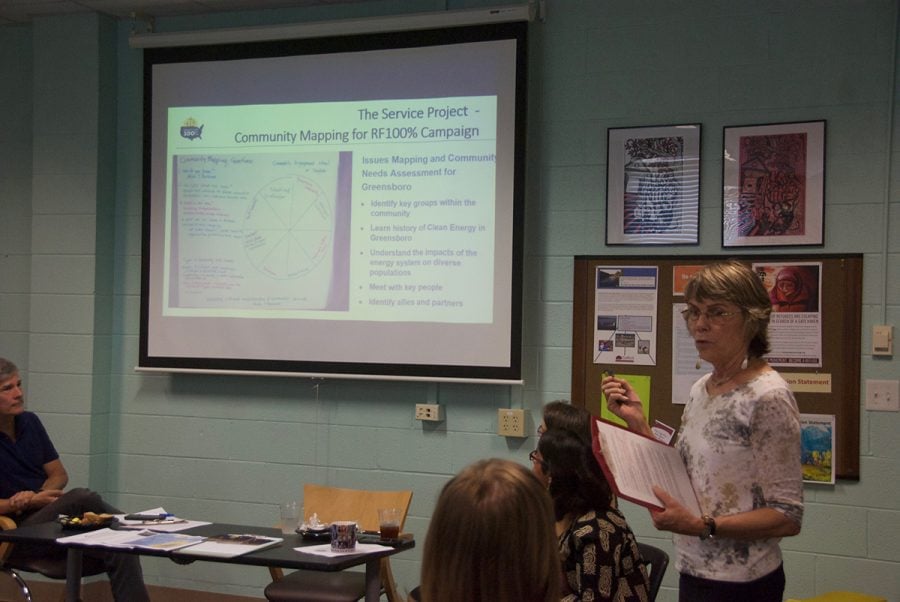Panel shows why NC could turn to renewable energy
Presenter Kathe Latham explains the benefits of clean energy during the climate change panel that took place on on Saturday, Sept. 8 in King Hall. // Photo By: Ezra Weiss/The Guilfordian
According to the United States Department of Energy, only 25.73 percent of North Carolina’s electricity is currently derived from renewable sources. Panelists, Margaret Rowlett, a member of the Greensboro Earth Quakers, and Kathe Latham and Shawn Berry, two representatives from the Sierra Club’s Ready for 100 campaign, hope to increase this number.
A lunch panel discussing climate change and the future of renewable energy in North Carolina was held on Tuesday, Sept. 4 in King Hall. The panel organized in advance of a larger rally held at Greensboro College on Saturday, Sept. 8, focused on the benefits of renewable energy, the urgency of climate change and potential practical techniques which could be utilized to promote the initiative.
The panel began with the speakers emphasizing the importance of focusing on a just transition to renewable energy in North Carolina, along with possible techniques which could be implemented as a means to achieve that goal.
“First and foremost, it is about a just transition,” Latham said. “This is really the challenge of the century, to implement a just transition to 100 percent renewable energy in our community.”
Rowlett advocated for the use of nonviolent direct action, suggesting techniques like symbolic public acts and group representations to ensure community leaders are aware of their respective initiative.
“We don’t have to only write letters to our representatives, or only show up to rallies,” Rowlett said. “There are a lot of different ways we can utilize direct nonviolent action.”
Rowlett also suggested modeling action in North Carolina after previously successful protests, led by the Earth Quaker Action Team in Philadelphia. Designed to convince the Philadelphia Energy Company to begin the transition to solar power, the protests by the Earth Quaker Action Team were successful in doubling PECO’s solar panel usage.
Using techniques similar to those employed by the Team, Rowlett believes that such community efforts will be successful in North Carolina.
Panelists additionally focused on a general plan for transitioning North Carolina to 100 percent renewable energy.
Berry presented a chart detailing a rough breakdown of where the electricity for a 100 percent renewable energy city would come from. According to the chart, the greatest amount of energy comes from the efficiencies gained by transitioning away from non-renewables.
Berry explained how a considerable portion of the energy transferred is lost as heat when fossil fuels are utilized in electricity generation, and because renewable energy sources do not suffer from this drawback, most renewable energy sources are considerably more efficient than their non-renewable counterparts.
Following discussion about renewable energy sources and prospective protest techniques, the panelists discussed the primary goals of Solar Power Now, a coalition organized to promote the usage of solar panels, aiming to increase this percentage to 100 by the year 2035.
The group is focused on ensuring that the transition to renewable energy does not negatively impact the community. In working with the Solar Power Now Coalition, Rowlett hopes that the Solar Power Now initiative will be successful in convincing local governing bodies for change.
“I am really optimistic that the city council will be ready to do something about this issue,” Rowlett said. “It is doable to get our community to 100 percent renewable energy by the year 2035.”
Attendees, including Assistant Professor of Geology Holly Peterson, expressed concerns about the effects of climate change and the importance of transitioning to renewable energy.
“Climate change is one of the biggest issues impacting this generation and the next,” said Peterson. “Renewable energy is an equitable way to tackle the problem.”
Guilford College has recognized the importance of renewable energy and has begun its transition as a community to implement renewable energy with the installation of nearly 200 solar panels on buildings across campus. These solar panels are used to heat water, producing more than 9,000 gallons of hot water every day.









